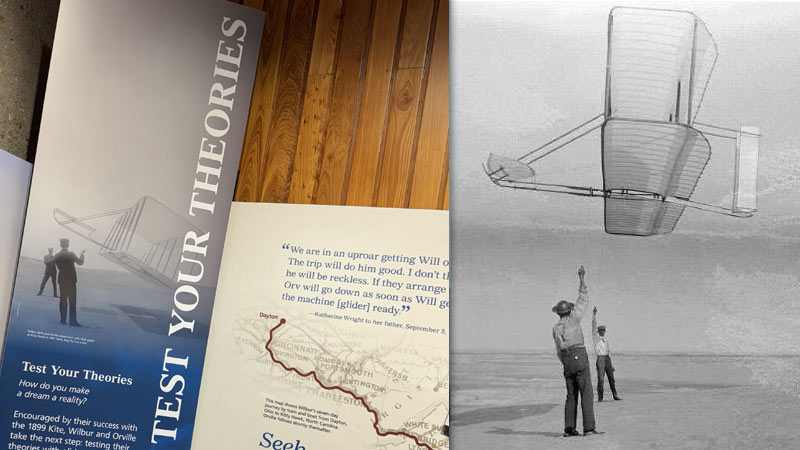
[ In celebration of the 10th anniversary of the release of Penguins Can’t Fly this month, this is the second in a series of lessons we can learn from some historical rulebreakers, Wilbur and Orville Wright. ]
Go big or go home.
It’s lionized as the recipe for success; to quit your job, cash in your life savings, and bet the farm.
It’s also terrible advice.
Our movies, history books, and culture are filled with adventurous daredevils who risked it all and overcame long odds. They make for exciting stories that can be told in under two hours, but they are the exception, not the norm. And even then, they are rarely the overnight successes we’re led to believe.
The Wright Brothers were not an overnight success.
Their historical achievement was the culmination of many small steps, taken deliberately, amidst a sea of setbacks.
There were many others dedicated to achieving the dream of flight. Bigger names with bigger budgets who attempted bigger things in front of bigger crowds.
Samuel Langley was one. He was an astronomer, physicist, and secretary of the Smithsonian Institution who used large contributions from the U.S. War Department and his friend Alexander Graham Bell to fund the motor-powered airship called the “The Great Aerodrome.” Smart money would’ve been all-in on Langley being the first to make history. He was going big.
The Wrights employed a different strategy.
They started small, with hand-built kites designed to help them test their theories from the ground. They kept the motor for last, instead focusing their attention on understanding and mastering lift, balance, and control.
They didn’t dramatically quit their day job to chase their dream. Instead, they hired someone to help manage their bicycle shop and used the profits from the business to help fund their side hustle.
They were courageous, but not foolish. Unlike other daredevils who risked their lives on attention-getting stunts, the Wrights were cautious, paying close attention to advance preparations. One reason they chose Kitty Hawk as a testing ground for their first attempts was for its sandy dunes that provided softer landings when things went wrong.
Wilbur said, “The man who wishes to keep at the problem long enough to really learn anything positively must not take dangerous risks. Carelessness and overconfidence are usually more dangerous than deliberately accepted risks.“ Because of this philosophy, the brothers decided to never fly together, so that if one were to be killed, the other could still carry on with the work.
They didn’t rush. Time and again, many competitors, including Langley, seemed poised to beat them to the finish line and into the history books. Still, the brothers refused to rush or take unnecessary risks. Even after their initial success in 1903 and the demand increased to prove their invention with a public demonstration, they played the long game. Wilbur and Orville kept their cool and took their time, refusing to panic, which helped avoid costly errors. Said Wilbur, “A man who works for the immediate present and its immediate rewards is nothing but a fool.“
They didn’t have big funding. In the end, all others failed, including Langley, whose Great Aerodrome suffered very big, very publicized failures. All the massive funding — nearly $70,000, the greater part of it public money — proved fruitless. The brothers’ total expenses including travel to and from Kitty Hawk, came to a little less than $1,000, paid entirely from the proceeds of their bicycle business. In today’s dollars, that’s the equivalent of about 2.5 million dollars versus just $36,000.
When it comes to achieving success in life, it’s tempting to figure out how to win big in one fell swoop. Pedal to the metal. Swing for the fences. Push all your chips to the center of the table.
The real trick is to keep playing the game.
It’s not sexy, but it keeps you from getting bankrupt or dead. Which buys you the time you need to take all the small steps required to cross the finish line.
Success is a game of inches.
You can waste time believing in fairy tales about magic formulas if you’d like. But the best relationships, teams, and businesses are the culmination of progress made one inch at a time. You can make great strides as a parent or leader by making one small change in your approach. The life or business you’ve always dreamed of can begin with signing up for one class, making one phone call, or reading one book.
In his book, The Wright Brothers, David McCullough writes about the first time the brothers flew together:
“…on this day at Huffman Prairie, where they had developed the first practical flying machine ever, the two of them, seated side by side, took off into the air with Orville at the controls. To many then and later, it seemed their way of saying they had accomplished all they had set out to do and so at last saw no reason to postpone any longer enjoying together the thrill of flight.”
The “go big or go home” approach seems bolder and is definitely more dramatic, but I’d argue it’s the easier path. Even if the result is a failure, at least you have your answer quickly. Staying patient and persevering amidst uncertainty is very difficult indeed.
I suspect that made the brothers’ first flight together after all those years of inches the sweetest flight of all.
Leave a Reply